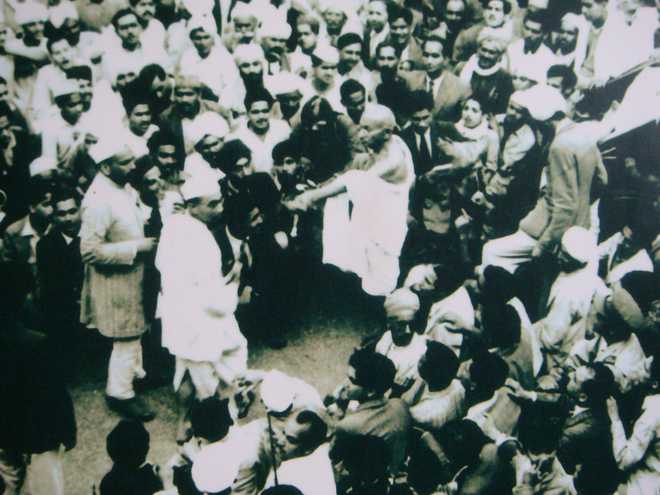Raaja Bhasin
Gandhiji never cared for Shimla. To him, this was a place far removed from the people and problems of India. These insulated heights did not feel the pain of the common man — the endlessly toiling peasant for whom he had so much regard and sympathy. He loathed the human-pulled and pushed rickshaw, which was the standard mode of transport in the town. Yet, as the strings of the British Empire were held in the ‘summer capital’, he came here several times between 1921 and 1946, for meetings and discussions and addressed large and small gatherings.
When Gandhiji first came to Shimla in 1921, he stayed at a house named ‘Shanti Kuti’ in the Chakkar area of Shimla. He was accompanied by his wife, Kasturba, Pandit Madan Mohan Malviya, Lala Lajpat Rai and the Ali brothers —Shaukat and Mohammed; the latter two were leaders of the ‘Khilafat Committee’ that was critical of the treatment meted out to the Khalifa (the Caliph) by the British at the end of the First World War. Huge crowds moved wherever he went and the cries of ‘Be-taj Badshah ki Jai’ (Hail to the uncrowned king) rented the air around the gates of the Viceregal Lodge when he went to meet Lord Reading on May 13, 1921.
On May 14, 1921, Gandhiji addressed a gathering of women at the Arya Samaj Hall in the Lower Bazaar. Surrounded by hundreds of men and children as well as a few women, he then went to Fir Grove, the residence of Rai Bahadur Mohan Lal, where a select gathering of Shimla residents had been invited for an interaction with him.
Rai Bahadur Mohan Lal (1890-1932) came from Garli village in Kangra and became a lawyer in Shimla. With shrewd partnerships and by sheer force of his personality, he became a wealthy and influential person. Mohan Lal went on to become a municipal commissioner, an elected member of the Punjab Legislative Assembly and played a major role in the infamous ‘Coolie Murder Case’ of 1925.
As Mohan Lal prospered, he left his Lower Bazaar house and purchased ‘Manorama’ that was acquired by the government and is now with the Indian Army. He then bought a substantial property, Fir Grove, which lies in Jakho hills’ lower slopes. In 1931, it was this house where Gandhiji stayed. Coming to Shimla that year, from the railway station, Mahatma Gandhi refused to use a rickshaw and special permission was given to take four cars to Fir Grove over a short stretch of the Mall between today’s High Court and Fir Grove. Another first was to take place that year, and Gandhiji addressed a huge gathering on the Ridge. Gandhi Ji’s staunch supporter Mohan Lal had an untimely death at the age of 42.
On June 28, 1940, Mahatma Gandhi again came to Shimla and had a long meeting with the Viceroy the following day. Accompanied by Mahadev Desai and Pyarelal, Gandhiji returned in September and had his first meeting with the Viceroy on the 27th. He decided to stay on in Shimla for a few days and as earlier in the year, he stayed with Rajkumari Bibiji Amrit Kaur at her residence Manorville, in Summer Hill. The daughter of Raja Harnam Singh of Kapurthala, Amrit Kaur was a devoted follower and supporter of Gandhiji. She was repeatedly imprisoned for her role in the freedom struggle. In 1942, she was placed under house arrest at Manorville and guarded by the police; she remained there for the next two years. After Independence, she was a member of the Constituent Assembly that framed the Constitution of India and became India’s first lady Cabinet minister. The All India Institute of Medical Sciences was created at the initiative of the then Prime Minister Jawaharlal Nehru and her. Then, along with a brother, she donated Manorville to the Indian Council of Medical Sciences.
(The writer is an author, historian and journalist)
Amrit Kaur, a staunch follower
Mahatma Gandhi decided to stay on in Shimla for a few days and as earlier in the year, he stayed with Rajkumari Bibiji Amrit Kaur at her residence, Manorville, in Summer Hill.
Amrit Kaur, daughter of Raja Harnam Singh of Kapurthala, was a devoted follower and supporter of Gandhiji. In 1942, she was placed under house arrest at Manorville and guarded by the police; she remained there for the next two years.
The Department of Language, Art and Culture, Himachal Pradesh, is placing plaques at places connected with Gandhiji in Shimla and has charted a walk-trail connected with the Mahatma.
Unlock Exclusive Insights with The Tribune Premium
Take your experience further with Premium access.
Thought-provoking Opinions, Expert Analysis, In-depth Insights and other Member Only Benefits
Already a Member? Sign In Now










